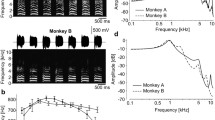Abstract
One vocalization in the Japanese macaque (Macaca fuscata) system of communication is the “girney.” Previous studies indicated that the “girney” is used for short range communication and that it tends to occur when subordinate animals approach and groom dominant ones and when females without infants approach females who have infants. Data were collected on the social behavior of adult female Japanese monkeys of the Arashiyama-A troop in Texas in order to test those results. The study indicates that “girneys” are the most frequently occurring vocalizations of females during and following the birth season and that they occur primarily in two contexts. Those are the proximity of a female to another female with a new infant and the proximity of a lower ranking animal to a higher ranking one. The contexts are ones in which the risk of aggression is high, and the “girneys” appear to function as appeasement gestures to reduce the risk.
Similar content being viewed by others
References
Altmann, J., 1974. Observational study of behavior: Sampling methods.Behaviour, 49: 227–267.
Bernstein, I. & C. Ehardt, n.d. The influence of kinship and socialization on aggressive behavior in rhesus monkeys. (Unpub. manuscript).
Bullard, J., 1984. Mount prompting behaviors of female Japanese macaques (Macaca fuscata). Unpub. M.A. thesis, Univ. of Alberta, Alberta.
Eaton, G. G., 1978. Longitudinal studies of sexual behavior in the Oregon troop of Japanese macaques. In:Sex and Behavior, Status and Prospectus,T. McGill,D. Dewsberry, &B. Sachs (eds.), Plenum Press, New York, pp. 35–59.
Ehardt, C. &B. Blount, 1984. Mother-infant visual interaction in Japanese macaques.Develop. Psychobiol., 17: 391–405.
Ehardt-Seward, C., 1980. The structure of social relationships in infant Japanese macaques (Macaca fuscata). Unpub. Ph.D.2 dissertation, Univ. of Texas, Austin.
Fedigan, L., 1976.A Study of Roles in the Arashiyama West Troop of Japanese Monkeys (Macaca fuscata). Contributions to Primatology, Vol. 9, S. Karger, Basel.
Gouzoules, H., 1980. Biosocial determinants of behavioral variability in infant Japanese monkeys (Macaca fuscata). Unpub. Ph.D. dissertation, Univ. of Wisconsin, Madison.
————,S. Gouzoules, &L. Fedigan, 1983. Male Japanese monkey mating strategies: Are female reproductive cues available?Amer. J. Primatol., 4: 344–345.
Green, S., 1975. Variation in vocal pattern with social situation in the Japanese monkey (Macaca fuscata): A field study. In:Primate Behavior, Vol. 4,L. Rosenblum (ed.), Academic Press, New York, pp. 1–102.
Horrocks, J. &W. Hunte, 1983. Rank relations in vervet sisters: A critique of the role of reproductive value.Amer. Naturalist, 122: 417–421.
Itani, J., 1963. Vocal communication of the wild Japanese monkey.Primates, 4(2): 11–66.
Itiogawa, N., 1973. Group organization of a natural troop of Japanese monkeys and mother-infant interactions. In:Behavioral Regulators of Behavior in Primates,C. Carpenter (ed.), Lewisburg, Pennsylvania, pp. 229–250.
Koyama, N., 1970. Changes in dominance rank and division of a wild Japanese monkey troop in Arashiyama.Primates, 11: 336–390.
Kurland, J., 1977.Kin Selection in the Japanese Monkey. Contributions to Primatology, Vol. 12, S. Karger, Basel.
McDonald, M., 1983. The courtship behaviour of female Japanese monkeys. Unpub. M.A. thesis, McMaster Univ., Ontario.
Mori, A., 1975. Signals found in the grooming interactions of wild Japanese monkeys of the Koshima troop.Primates, 16: 107–140.
Wolfe, L., 1976. Sexual behavior of the Arashiyama West troop of Japanese macaques (Macaca fuscata). Unpub. Ph.D. dissertation, Univ. of Oregon, Eugene.
Author information
Authors and Affiliations
About this article
Cite this article
Blount, B.G. “Girney” vocalizations among Japanese macaque females: Context and function. Primates 26, 424–435 (1985). https://doi.org/10.1007/BF02382457
Received:
Accepted:
Issue Date:
DOI: https://doi.org/10.1007/BF02382457




